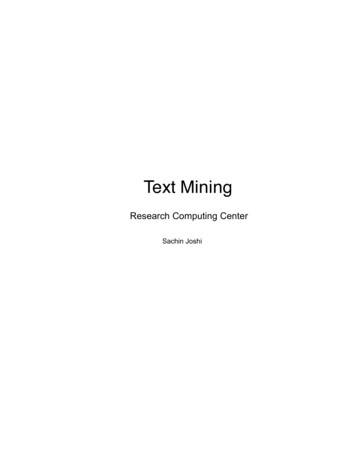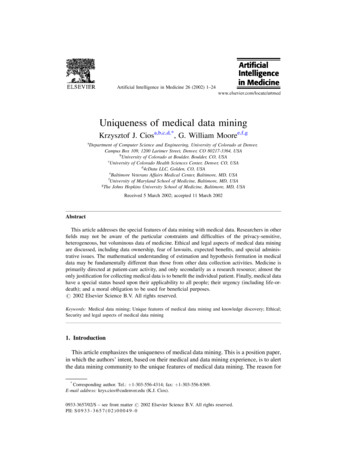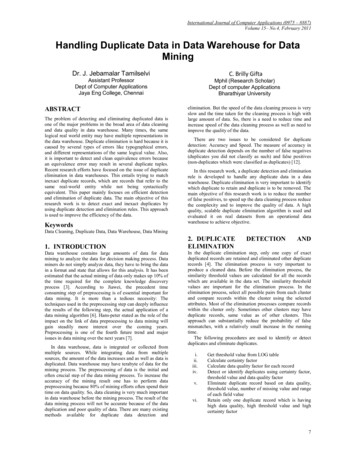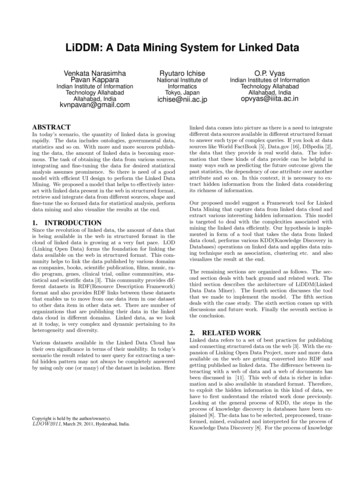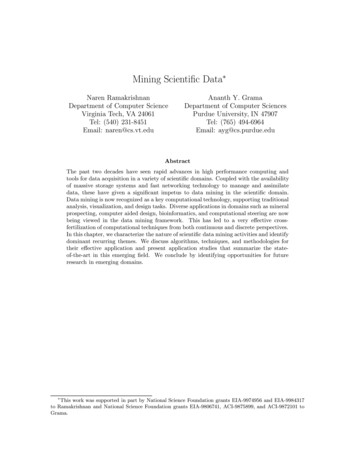
Transcription
Mining Scientific Data Naren RamakrishnanDepartment of Computer ScienceVirginia Tech, VA 24061Tel: (540) 231-8451Email: naren@cs.vt.eduAnanth Y. GramaDepartment of Computer SciencesPurdue University, IN 47907Tel: (765) 494-6964Email: ayg@cs.purdue.eduAbstractThe past two decades have seen rapid advances in high performance computing andtools for data acquisition in a variety of scientific domains. Coupled with the availabilityof massive storage systems and fast networking technology to manage and assimilatedata, these have given a significant impetus to data mining in the scientific domain.Data mining is now recognized as a key computational technology, supporting traditionalanalysis, visualization, and design tasks. Diverse applications in domains such as mineralprospecting, computer aided design, bioinformatics, and computational steering are nowbeing viewed in the data mining framework. This has led to a very effective crossfertilization of computational techniques from both continuous and discrete perspectives.In this chapter, we characterize the nature of scientific data mining activities and identifydominant recurring themes. We discuss algorithms, techniques, and methodologies fortheir effective application and present application studies that summarize the stateof-the-art in this emerging field. We conclude by identifying opportunities for futureresearch in emerging domains. This work was supported in part by National Science Foundation grants EIA-9974956 and EIA-9984317to Ramakrishnan and National Science Foundation grants EIA-9806741, ACI-9875899, and ACI-9872101 toGrama.
Contents1 Introduction12 Motivating Domains2.1 Data Mining in Geological and Geophysical Applications . . . . . .2.2 Data Mining in Astrophysics and Cosmology . . . . . . . . . . . .2.3 Data Mining in Chemical and Materials Engineering Applications .2.4 Data Mining in Bioinformatics . . . . . . . . . . . . . . . . . . . .2.5 Data Mining in Flows . . . . . . . . . . . . . . . . . . . . . . . . .23569113 Inductive Mining Techniques3.1 Underlying Principles . . . . . . . . . . . . . . . . . . . . . . . . . . . . . . .3.2 Best Practices . . . . . . . . . . . . . . . . . . . . . . . . . . . . . . . . . . . .121216.4 Data Mining as Approximation and Lossy Compression194.1 Underlying Principles . . . . . . . . . . . . . . . . . . . . . . . . . . . . . . . 194.2 Best Practices . . . . . . . . . . . . . . . . . . . . . . . . . . . . . . . . . . . . 235 Putting It All Together265.1 Underlying Principles . . . . . . . . . . . . . . . . . . . . . . . . . . . . . . . 265.2 Best Practices . . . . . . . . . . . . . . . . . . . . . . . . . . . . . . . . . . . . 286 Future Research Issues6.1 Mining when Data is Scarce . . . . . . . . . . . .6.2 Design of Experiments . . . . . . . . . . . . . . .6.3 Mining ‘On-The-Fly’ . . . . . . . . . . . . . . . .6.4 Mining in Distributed and Parallel Environments7 Concluding Remarks.303033343434
Mining Scientific Data11IntroductionComputational simulation and data acquisition in scientific and engineering domains havemade tremendous progress over the past two decades. A mix of advanced algorithms, exponentially increasing computing power, and accurate sensing and measurement devices haveresulted in terabyte-scale data repositories. Advances in networking technology have enabled communication of large volumes of data across geographically distant hosts. This hasresulted in an increasing need for tools and techniques for effectively analyzing scientificdatasets with the objective of interpreting the underlying physical phenomena. The processof detecting higher order relationships hidden in large and often noisy datasets is commonlyreferred to as data mining.The field of data mining has evolved from its roots in databases, statistics, artificialintelligence, information theory, and algorithmics into a core set of techniques that havebeen successfully applied to a range of problems. These techniques have come to rely heavilyon numerical methods, distributed and parallel frameworks, and visualization systems toaid the mining process. In this chapter, we characterize the nature of scientific data miningactivities and identify dominant recurring themes. We discuss algorithms, techniques, andmethodologies for their effective application, and present application studies that summarizethe state-of-the-art in this emerging field.The diverse and rich background of data mining is reflected in the many distinct viewstaken by researchers of this evolving discipline. Some of these dominant views are summarized here:Mining is InductionPerhaps the most common view of data mining is one of induction i.e., proceeding from thespecific to the general. This basis finds its roots in the artificial intelligence and machinelearning communities and relies on techniques ranging from neural networks [Fu, 1999] toinductive logic programming [Muggleton, 1999]. Systems such as PROGOL (not PROLOG),FOIL, and Golem view induction as reversing the deduction process in first-order logic inference. Barring any specific constraints on the nature of induced generalizations, one way togenerate (mine) them is to systematically explore and analyze a space of possible patterns.This idea of ‘generalization as search’ was first proposed by Mitchell [Mitchell, 1982] and hassince resurfaced in various domains, most notably the association-rules mining algorithmof [Agrawal et al., 1993] used in commercial market basket analysis. The key idea in thisresearch is to use partial orderings induced by subsumption relations on a concept spaceto help prune the search for possible hypotheses. Areas that deal most directly with thisperspective include Sections 3 and 5.Mining is CompressionThe process of learning a concept from an enumeration of training sets typically leads to avery large space of possible alternatives. Often, the most desirable of these concepts is theone that is most succinct or that is easiest to describe. This principle, known as Occam’sRazor, effectively equates learning to compression (where the learned patterns are, in somesense, “smaller to describe” than exhaustively enumerating the original data itself). Theemergence of computational learning theory in the 1980s and the effectiveness of models
Mining Scientific Data2such as MDL (the Minimum Description Length principle) have provided a solid theoreticalfoundation to this perspective. Several commercial data mining systems employ this aspectto determine the feasibility of the mined patterns. For example, if the description of adefective machine part is longer than an enumeration of possible defective parts, then thelearned concept is not very useful.Mining is QueryingThe view of mining as intelligently querying a dataset was first projected in the databasesystems community. Since most commercial and business data resides in industrial databasesand warehouses, mining is often viewed as a sophisticated form of database querying. SQL,the de-facto standard for database query languages, currently, does not support queries ofthe form “find me all machine parts in the database that are defective.” The querying aspectallows embedding of mining functions as primitives into standard query languages. As morescientific and engineering data finds its way into databases and XML formats, this form ofquerying will become more important. It is conceivable that systems might support standardqueries of the form ‘highlight all vortices within specified flow data’ in the near future. Thisperspective is currently most popular in the commercial and economic mining community.Its implications for mining scientific data are discussed in Section 5.Mining is ApproximationMining is often also thought of as a process of systematic approximation. Starting froman exact (lossless) data representation, approximations are introduced in the hope of finding some latent/hidden structure to the data. Such approximations might involve droppinghigher-order terms in harmonic approximations, adaptive simplification of geometries, orrank reduction in attribute matrices. A very popular technique that has this flavor is calledLatent Semantic Indexing [Berry et al., 1999, Berry et al., 1995, Berry and Fierro, 1996,Jiang et al., 1999, Letsche and Berry, 1997], an algorithm that introduces approximationsusing singular value decompositions of a term-document matrix in information retrieval tofind hidden structure. This has parallels in Karhunen-Loeve expansions in signal representation and principal component analysis in statistics. A surview of such data reductiontechniques appears in [Barbara et al., 1997]. Section 4 most directly deals with this perspective.2Motivating DomainsAs the size and complexity of datasets gathered from large scale simulations and high resolution observations increases, there is a significant push towards developing tools for interpreting these datasets. In spite of its relative infancy, the field of scientific data mining hasbeen applied with significant success in a number of areas. In this section, we outline somekey application areas and the data mining tasks within these with a view to motivating thecore techniques underlying common data mining tasks. The survey presented is by no meanscomprehensive. Other applications abound in areas such as computational biology, scientificvisualization, robotics, and wireless communications.
Mining Scientific Data2.13Data Mining in Geological and Geophysical ApplicationsData mining applications in geology and geophysics were among the first to be pursued andhave achieved significant success in such areas as weather prediction, mineral prospecting,ecological modeling, landuse analysis, and predicting earthquakes from satellite maps. Aninteresting aspect of many of these applications is that they combine spatial and temporalaspects, both in the data as well as the phenomena being mined.Datasets in these applications come both from observations and simulation. A prototypical example from weather forecasting relies on data that is typically defined over a grid ofobservation stations or finite difference simulation models. The underlying variables definedover these discretizations include horizontal velocities, temperature, water vapor and ozonemixing ratio, surface pressure, ground temperature, vertical velocities, precipitation, cloudiness, surface fluxes of sensible and latent heat, surface wind stress, and relative heating. Suchdata is typically captured at periodic snapshots. For example, in the Atmospheric GlobalCirculation Model (AGCM), at the lowest grid resolution (4 degree latitude 5 degree longitude 9 atmospheric levels), storing data at periods of 12 hours results in over 5 GB ofdata per year.Data analysis proceeds with respect to a variety of atmospheric phenomena, such ascyclones, hurricanes, and fronts. The key challenge in analyzing atmospheric data is theimprecise definition of weather phenomena. For example, cyclones are typically definedbased on a threshold level of vorticity in quantities such as atmospheric pressure at sea level.Other techniques for detecting cyclones rely on determination of local extrema of the sea levelpressure [Huang and Zhao, 1998]. The outcome of an automated cyclone detection techniqueis a one-dimensional track in three dimensional space consisting of two space coordinates andone time coordinate. Other weather-related phenomena such as blocking features can also bedetected using similar techniques. Blocking features are characterized by well defined timescales (in the range of weeks) with a westerly flow that is split into two branches. Thesepersistent anomalies are measured by examining the variation of geopotential height fromthe expected value.The spatio-temporal nature of most of the analysis tasks makes them extremely challenging. The temporal aspect is typically modeled by characterizing the short-range andlong-range dependence of processes on various forms of time series analysis. Spatial aspectsare modeled using point-process techniques, particularly in weather-related phenomena. Forexample, storms are viewed as an agglomerate of rain-producing cells distributed over thearea within which rain is occurring. These cells are assumed to be stationary and to bedistributed in space either independently according to a Poisson process, or with clusteringaccording to, say, a Neymann-Scott scheme. In addition, fits to empirical data are achievedby including random variables in the problem formulation to correlate between the durationsof cells within a single storm.The modeling, detection, and prediction of global climate phenomena has received muchattention in the high performance computing community [Semtner, 2000]. Such applicationsinvolve multiple models at varying levels of fidelity (and often multi-disciplinary), parallelcomputing, and robust methodologies for ensuring that predictions agree with observedbehavior. The extreme sensitivity of such phenomena (folklore has that, possibly incorrectly,‘a bird flapping its wings in Switzerland can cause thunderstorms in the United States’)and interactions between ocean and atmospheric processes make this problem a promising
Mining Scientific Data4Figure 1: Landuse segmentation of the Upper Roanoke River Watershed in Southwest Virginia, USA. Areas marked ‘Unclassified’ and ‘Mixed Forest’ pose difficulties for evaluatingthe effect of settlement patterns. Data mining can help identify mislabeled areas and correlate unlabeled regions with known land cover features. Figure courtesy R. Dymond (VirginiaTech).application area for data mining. Effects ranging from warming of the oceans (e.g. ElNiño) to the compensatory behavior of monsoons in tropical areas (e.g. the Southwestand Northeast monsoons in the Indian subcontinent) are important in assessing chances ofdrought, harsh winters, flooding, and in the management of water resources.One of the early successful mining systems for scientific data was CONQUEST (CONcurrent Querying in Space and time) [Stolorz et al., 1995]. This system was designed tohandle datasets with significant temporal coherence in events and to enable complex multimodal interactive querying and knowledge discovery. Han et al. [Koperski et al., 1998]provide a survey of techniques for mining geographical data, with specific emphasis ondatabase perspectives and clustering, including their CLARANS algorithm for spatial mining[Ng and Han, 1994].Rapid advances in remote sensing have also resulted in large repositories of high-resolutionimagery that pose significant challenges for data handling and analysis. One of the analysistasks that has received some attention is the prediction of the motion of surface faults during an earthquake [Preston et al., 2000]. QUAKEFINDER [Stolorz et al., 2000] is one suchsystem that applies machine learning techniques to the measurement of plate displacementsduring earthquakes by comparing successive satellite images of a fault-laden area. Similarapproaches are being applied to a number of applications relating to monitoring continuousand abrupt tectonic activity, land cover dynamics, and global climate changes.
Mining Scientific Data5In addition, datasets from remote sensing are typically characterized by mislabeledor unavailable information (see Fig. 1). While this problem is endemic to many experimental disciplines, it causes particular hardship for applications such as watershed assessment, where landuse distributions and settlement patterns are important drivers of change[Rubin et al., 2000]. They affect surface and groundwater flows, water quality, wildlife habitat, economic value of the land and infrastructure (directly due to the change itself suchas building a housing development, and indirectly due to the effects of the change, such asincreased flooding), and cause economic effects on municipalities (taxes raised versus servicesprovided). Modeling such effects in a system requires the accurate and effective determination of landuse classifications; however, out-of-date field measurements, lack of knowledgeof precise commercial and vegetation boundaries often result in mislabeled training data[Brodley and Friedl, 1999], thus posing bottlenecks in data mining. The more broader taskof map analysis using geographical information system (GIS) data is important in identifyingclusters of wild life behavior in forests [Berry et al., 1994], modeling population dynamics inecosystems [Abbott et al., 1997], and socio-economic modeling [Berry et al., 1996].An important application of data mining in geophysics relates to the detection of subsurface mineral deposits, oil reservoirs, and other artifacts. Typical datasets in these applications are collected from excitation and observation stations in borewells. For example,an agent is injected into one of the borewells and measurements are made at nearby observation bores. Such measurements are typically taken at regular intervals (and thus thetemporal nature of data) over pre-specified observation points. Carefully examining thisdata for artifacts reveals presence (or absence) of phenomena being studied. An approach tomining porosity of prospect regions by automatically deriving analytic formulae is describedin [Li and Biswas, 1995]. Such applications are characterized by great economic importance,and the accompanying need to ensure privacy and confidentiality in data mining. Othercomputational aspects of earth systems science can be found in the May-June 2000 SpecialIssue of IEEE/AIP CiSE on this topic [Rundle, 2000].2.2Data Mining in Astrophysics and CosmologyThe recent past has seen an explosion in the amount of data available to astrophysicistsfor analyzing a wide variety of phenomena. This data holds the key to such fundamentalquestions as the origins of the universe, its evolution, the structures that lie deep within,and the presence of extra-terrestrial lifeforms. A number of researchers are actively workingon various high-profile projects relating to analysis of astrophysical data.The main source of astrophysical data is in the form of surveys of the sky in differentsegments of the electromagnetic spectrum. We are rapidly getting to the point where surveysare generating more data than can be assimilated by semi-automated means. SKICAT (SkyImage Classification and Archiving Tool) was one of the early systems that recognized theneed for automated analysis of large-scale sky surveys [Fayyad et al., 1993, Weir et al., 1995].SKICAT was also instrumental in popularizing data mining in the scientific community. Thegoal was to provide an automated means for analyzing data from the Palomar ObservatorySky Survey (POSS-II), which consists of approximately 107 galaxies and 108 stars. Themagnitude of this data clearly precludes manual analysis. The SKICAT system attemptedto address the basic question of determining which of the objects in the survey belong tovarious classes of galaxies and stars. The system extracts a variety of features derived from
Mining Scientific Data6image processing techniques and uses a tree classifier to classify celestial objects into oneof several known classes. More recently the Sloan Digital Sky Survey [Szalay, 1999], on theorder of terabytes, is expected to become the benchmark reference for knowledge discoveryin computational cosmology. See [Szalay, 1999] and other articles in the March-April 1999special issue of IEEE/AIP CiSE [Tohline and Bryan, 1999] for more information on suchprojects.One of the key sources of data relating to the origin of the universe is believed to becosmic background radiation (CMB). This radiation provides an excellent measure of theinhomogeneities in the distribution of matter in the universe over a period of billions ofyears. Fluctuations in photon intensity indicate the variations in density and velocity ofradiation at a point when the universe was highly ionized. They also provide informationabout the amount of gravitational clustering during different epochs in the universe’s historythrough which the photons pass [Hu, 1996]. Telescopes such as Hubble and Keck have madevisible galaxies that are at much earlier stages of their evolution than the Mikly Way. Thiswill potentially enable us to chart our own evolution if we can effectively analyze radiationdata. Large scale CMB data is available from a variety of astrophysical experiments suchas COBE [Bennett et al., 1996, Leisawitz, 1999], BOOMERANG [de Bernardis et al., 2000],MAXIMA [Lee et al., 1998], and Planck [Bersanelli et al., 1996]. A complete analysis ofCMB requires large scale simulation and analysis of full-sky maps at very high resolutions.Recently, a project by the name SETI@home (Search for Extraterrestrial Intelligence [Anderson et al., 1999]) gained prominence due, in large part, to its ingenious approachto harnessing the large computational resources of the Internet. This project analyzes datacollected from the Arecibo Radio Telescope in Puerto Rico to search for patterns and anomalies indicating extraterrestrial intelligence. The data is parceled into packets of 330K andsent off to participating clients (to date, there have been more than two million client machines running the SETI analysis software). These clients look for interesting artifacts inthe data and report back potential anomalies to the server. ‘Interesting artifacts’ in thiscontext correspond to strong and steady signals in a narrow frequency band, pulsed signals,and continuous tones, among other features.In addition to addressing the issue of analyzing data from various parts of the electromagnetic spectrum, research has also focused on supporting tools and techniques. Thesetools include compression techniques, improved information storage and retrieval structures,distributed frameworks, and data fusion. Data fusion can play an important role in astrophysical applications since emissions in different ranges of the spectrum may correlate tomanifest interesting artifacts in data [Korn et al., 1997, Moore, 1998, Moore and Lee, 1998].2.3Data Mining in Chemical and Materials Engineering ApplicationsData mining challenges in chemical and materials engineering can be broadly classified intothe following categories: structure classification and prediction of properties, structureactivity relationships, and materials design.The problem of predicting the behavior of materials under various physical conditionshas been studied using regression analysis [Vashishta et al., 1996a, Vashishta et al., 1996b].Extensive experimental and simulation data has been used to compute such higher order relationships as “thermal conductivity and Young’s modulus of silicon nitride scalewith the density as ρ1.5 and ρ3.6” and that “pores appear in silicon nitride as density
Mining Scientific Data7Figure 2: Molecular dynamics simulation demonstrating a crack in an amorphous siliconnitride film. Slow intra-microcrack propagation produces smooth surfaces, while coalescenceof microcracks leads to rapid propagation and produces rough surfaces. The nature ofcrack surfaces is important in many application. The problem of extracting a crack surfacedynamically from large scale molecular dynamics simulation data is an important analysistask. Figure courtesy A. Nakano (Louisiana State University).reduces to 2.6 g/cc.” [Nakano et al., 1995]. Physical processes such as crack propagationand fracture surface characteristics have also been investigated (Figure 2). Data handlingand compression frameworks to support discovery of such relationships have been developed [Nakano et al., 1995, Yang et al., 1999].The goal of designing materials with specified properties is a more complex one considering the fact that the forward problem of predicting material properties is itself not completelyunderstood. Furthermore, applications involving life-expectancy based design require thatall or most parts of a structural component fail simultaneously. For this reason, heuristicsand machine learning approaches have a very important role to play in this area. Industrial applications of materials design include composites and blends, agricultural chemicals,refrigerants, solvents etc. With increased environmental awareness and concerns, greateremphasis is being placed on the design of novel materials.Traditional approaches to design of materials have relied on a trial-and-error paradigm.The complexity of this paradigm lies both in the large dimensionality of the search spaceand the need to guide the search process with appropriate heuristics. Computer aidedmaterials design (CAMD) has thus gained prominence over the recent past. CAMD fundamentally poses an inverse problem in which the structure must be inferred from function
Mining Scientific Data8Figure 3: Wireframe model of a wood-based composite showing failed layers (gray) and activelayers (black), and the orientation of fibers in each layer. In this figure, the second layerhas failed. The horizontal protrusions are proportional in length to the magnitude of forcesbeing applied to the layers at the time of failure. Data mining can help characterize failurecriteria, by taking into account fatigue data and domain specific background knowledge.Figure courtesy C.A. Shaffer (Virginia Tech).(or properties). A number of traditional approaches ranging from neural networks and genetic algorithms to tree classifiers have been explored by researchers. One such system —GENESYS [Venkatasubramanian et al., 1994, Venkatasubramanian et al., 1995], has beenfound to be useful in the design of several novel materials.Crack propagation studies and failure analysis are now becoming increasingly sophisticated with the advent of parallel molecular dynamics [Nakano et al., 1999], nanoscale simulations [Nakano et al., 1995], and problem-solving environments (PSEs) [Goel et al., 1999].Understanding how and why materials fail and fracture constitutes one of the grand challengeproblems in computational materials science. Fig. 3 describes a materials analysis scenarioinvolving wood-based composites [Goel et al., 1999]. The failure of one or more layers uponsimulation of various forces, as shown, helps in assessing the strength properties of reinforcedmaterials. Data mining in this context can help characterize interface phenomena from typical data sets which, in turn, can be utilized in adaptive control and dynamic analysis. In addition, technologies such as Micro-Electro Mechanical Systems (MEMS) open up the possibilityof designing smart and intelligent structures [Berlin and Gabriel, 1997], embedded internetdevices, and programmable vector fields for micromanipulators [Böhringer et al., 1997]. Suchdevices currently lack powerful programming abstractions and languages that can supportdistributed intelligence and large-scale autonomy.At a broader level, multidisciplinary analysis and design (MAD) of complex devices suchas gas turbine engines require knowledge and computational models from multiple disciplines. For example, the analysis of an engine involves the domains of thermodynamics(specifies heat flow throughout the engine), reactive fluid dynamics (specifies the behaviorof the gases in the combustor), mechanics (specifies the kinematic and dynamic behaviorsof pistons, links, cranks etc.), structures (specifies the stresses and strains on the parts)and geometry (specifies the shape of the components and the structural constraints). Thedesign of the engine requires that these different domain–specific analyses interact in orderto find the final solution. While these different domains might share common parameters
Mining Scientific Data9and interfaces, each of them is governed by its own constraints and limitations. Thereare now thousands of well defined software modules for modeling various parts and behaviors or for supporting the simulation process. For most design aspects, there are multiplesoftware modules to choose from. These embody different numerical methods (iterativeor direct solvers), numerical models (standard finite differences, collocation with cubic elements, Galerkin with linear elements, rectangular grids, triangular meshes), and physicalmodels (cylindrical symmetry, steady state, rigid body mechanics, full 3D time dependentphysics). Data mining can reveal the most appropriate models and algorithms to choose in aparticular situation, by mining benchmark studies involving batteries of standardized problems and domains [Drashansky et al., 1999]. Furthermore, such complex devices typicallyhave tens of thousands of parts, many of which experience extreme operating conditions.Important physical phenomena take place at spatial scales from tens of microns (combustion, turbulence, material failure) to meters (gas flow, rotating structures) and at temporalscales from microseconds to months. Modeling such complex phenomena can benefit fromtechniques such as qualitative computing [Forbus, 1997] and order-of-magnitude reasoning[Murthy, 1998, Nayak, 1992]. An excellent survey of computational techniques in mechanicsappears in [Noor, 1997].2.4Data Mining in BioinformaticsBioinformatics constitutes perhaps one of the most exciting and challenging application areas for data mining. This information-centric view of biology has ushered in a veritablerevolution in genomics involving technologies such as DNA sequencing and linkage analysis. A compelling frontier is the design of software tools that can harness and mine thecontinuing amount of data generated by such research efforts. Recently, Celera Genomics,Inc., Maryland, USA and the federally-funded multi-nation Human Genome Project haveannounced the creation of a rough map of the entire human genome. These studies attemptto discover all of the approximately 35,000—100,000 human genes and make them accessiblefor further biological study and to determine the complete sequen
of massive storage systems and fast networking technology to manage and assimilate data, these have given a signi cant impetus to data mining in the scienti c domain. Data mining is now recognized as a key computational technology, supporting traditional analysis, visualization, and design tasks. Diverse applications in domains such as mineral






